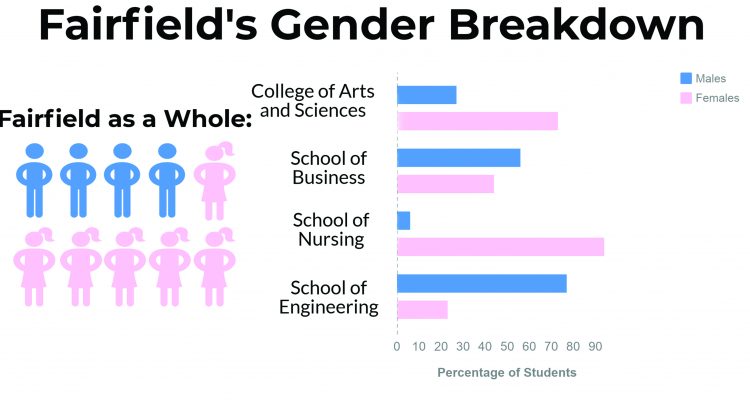When one thinks of majors, it is very easy to come to the conclusion that some majors or fields of study are predominantly male or female, however, the statistics behind it must be looked into to prove whether the preconceived notions are true.
Majors have certain stereotypical assumptions, such as that nursing is predominantly female, while others, such as engineering, would be predominantly male in composition.
According to the University’s Office of Institutional Research, for the Fall 2016 semester, the Colleges of Arts & Sciences as a whole consisted of 425 male undergraduate students and 1,162 female undergraduate students. This is in contrast to the Dolan School of Business, where the margin between male and female undergraduate students is much smaller, yet there are roughly 200 more males than females there as of Fall 2016.
The School of Engineering had a significant population of male students, coming in at 191 in total, as opposed to the 58 female students enrolled. The Marion Peckham Egan School of Nursing and Health Studies, by far, had the highest margin between male and female students, with 26 male students compared to 429 female students enrolled in the school.
Percentage-wise, the College of Arts and Sciences is 73 percent female and 27 percent male, while the Dolan School of Business is 44 percent female and 56 percent male.
The School of Nursing has a significant female population, coming in at 94 percent of its enrolled students, while the School of Engineering largely consists of male students, coming in at 77 percent.
One male nursing student, Justin Corbitt ‘19, stated that, “The male to female ratio is very drastic. In all of my classes it is either just me, or myself and one other guy. It is clearly a predominantly female profession. I have also yet to have a male as a teacher or instructor yet in the nursing school, nor do I even know if there are any.”
Corbitt added that, “Being a male nursing student I personally believe that more men should consider the profession of nursing. It has this stigma with it being a female job, but there should be no stigma for a profession where your goal is to preserve and nurture human life. There is a lot to offer in the nursing field and can range anywhere from working in a physician’s office, responding to emergencies in a helicopter, or going to a third world country and provide the best medical practice you can offer.”
As for the majority male engineering school, Julia Nojeim ‘19, Co-President of the Society of Women Engineers, felt that, “The gender ratio is prevalent in the School of Engineering but is closing which I think is very exciting. It’s great to see an increasing amount of both female engineering students and also prominent female engineering faculty, which is inspirational and motivational to see how they have succeeded in this field.”
In terms of the specific gender breakdown of the majors offered at the University, in the College of Arts & Sciences, the Vice President for Enrollment Management, Karen Pellegrino, noted that, “Applicants to the College of Arts and Sciences [from this past year] are approximately 30 percent male, and although there are slight differences in the gender breakdown across majors in the College of Arts and Sciences, the overall breakdown generally applies to individual majors in the college.”
Junior Lauren Sugantino, a student in the Dolan School of Business, felt as though, “The gender ratio in DSB is rather equal. In the majority of business classes I was in, there was a good mix of female and male. Sometimes more male or female depending on the class.”
Sugantino added, “I still think DSB should be more even in terms of gender. Most of the professors that teach business classes are majority all male. I only had two female professors when I took an intro to marketing class back in my sophomore year and in my freshman year for microeconomics.”
According to the University’s factbook from the Fall 2014 semester, the majors of students enrolled in full-time undergraduate programs in the CAS reflected that a large majority of students chose to study communication, psychology and English.
As for the University as a whole, percentage-wise, 60 percent of the total student population is made up of females, which is a 10 percent majority over the male student population.
In the Dolan School of Business, according to Pellegrino, “Applicants [from the past year] … are approximately 60 percent male.” For the Fall 2016 semester, according to the institutional research factbook, the Dolan School of Business has exactly 853 male students compared with 659 female students.


Leave a Reply